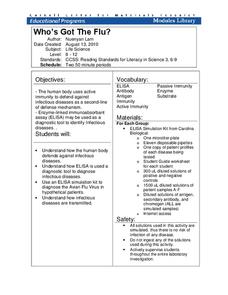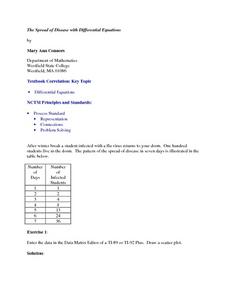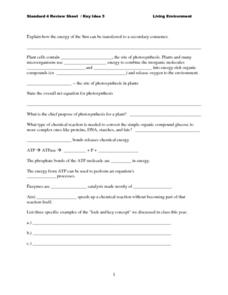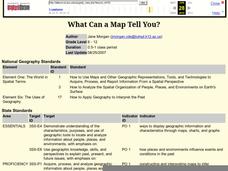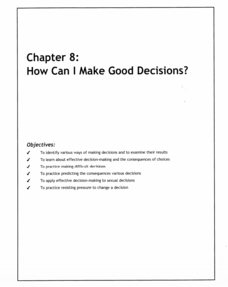Curated OER
Preventing Childhood Diseases Project
Second graders become informed advocates in the prevention of childhood diseases. This takes place during the Preventing Childhood Diseases Project.
Curated OER
Coping With Alzheimer's
High schoolers examine the coping skills that are necessary when dealing a loved who has Alzheimer's disease. They write using emotionally charged descriptive words after watching an associated video.
Cornell University
Who’s Got The Flu?
Become an immunologist for the day. Scholars elicit the use of the enzyme-linked immunoabsorbent assay (ELISA) to diagnose an infectious disease. Through the process, they learn about the immune system response to infectious diseases.
Teach Engineering
Heart to Heart
Begin a unit on the heart, the parts and the function of the heart, and about heart disease with a resource that includes a lecture, a PowerPoint presentation, and research information. The lesson is the first of a four-part series...
Hastings Prince Edward Public Health
My Life—My Reproductive Health
Keep learners informed about their options and rights when it comes to their sexuality. An in-depth lesson plan guides teenagers through a discussion on sexually transmitted diseases, teen pregnancy, and emotional consequences to having...
Curated OER
The Spread of Disease with Differential Equations
Twelfth graders solve problems using differential equations. In this Calculus lesson, 12th graders analyze data regarding the spread of a flu virus. Students use the symbolic capacity of the TI-89 to develop a model and...
Curated OER
Standard 4-Photosynthesis, Diseases and the Immune System
In this photosynthesis, disease and Immune System worksheet, students fill in the blanks with key terms to complete sentences about the transfer of energy from the sun to plants, enzymes as catalysts in reactions, homeostasis, the immune...
Curated OER
The Science of Microbes
Students will explore cells to understand that all living things are composed of cells. In this science lesson, students use the scientific process and work in cooperative groups to gain a better...
Curated OER
Disease and Epidemics
High schoolers explore how disease and epidemics have the potential to shape communities. They examine their impact on culture and specifically the literature of the time. Students investigate how trade routes accelerated the movement of...
Curated OER
Disease Role Play
Students develop an action plan in collaborative groups addressing a new disease. This activity provides 3 roles for student participation: scientists, public health officials and community leaders.
Curated OER
Factoring Out Disease
High schoolers identify and discuss health problems that can occur during adulthood. They research one health problem, list the risk factors of the disease, and create a Powerpoint presentation based on their research.
Curated OER
What Can a Map Tell You?
Students investigate how maps can provide useful information about health issues. They study a map to draw conclusions about cholera death in London.
Biology in Motion
Urine Concentration in 3 Easy Steps
The color, density, and smell of urine all relate to kidney function. Pupils observe the kidney controlling the concentration of water through three different steps. It mentions how each function might change the appearance and scent of...
Give and Let Live
Blood and Transplant: Blood
Why is blood donation so important, anyway? Science and health classes across multiple grades benefit from an in-depth look into the need for and process of blood donation. With an emphasis on presenting the topic in a non-threatening...
Virginia Department of Education
Meiosis
Intrigue the class by completing a lesson on meiosis, filled with challenging and insightful activities to spark the interest of every person in the room. Each member of the class learns about genetic disorders due to faulty meiosis, and...
Howard Hughes Medical Institute
Winogradsky Columns: Microbial Ecology in the Classroom
Winogradsky columns are ideal for observing the role of bacteria and other microorganisms in an ecosystem. This student activity guide is complete with data tables for observations and analysis questions for processing what was observed....
Advocates for Youth
How Can I Make Good Decisions?
Your entire life can change as a result of one decision—for better or for worse. Guide middle and high schoolers through the process of making decisions and weighing the consequences in the midst of peer pressure and other influences.
Curated OER
Diversity of Life: Pathogens
Students research bacteria and viruses that carry pathogens. In this diversity lesson, students examine how pathogens spread disease through bacteria and viruses. Students write a report on disease caused by bacteria or virus including...
Curated OER
Bacteria in Your Life
In this bacteria worksheet, students describe the process that kills harmful bacteria in milk. Then they describe what types of bacteria are helpful to farmers and which two plants have these bacteria in their roots. Students also name...
Curated OER
Science In Society
Fifth graders study diseases that are related to the use of alcohol, tobacco, and drugs, both prescription and illegal. They determine illnesses that can occur as a direct result of the use of or inappropriate use of these substances....
Curated OER
The Cantankerous Pathogen
Students explore what factors influence the spread of infectious diseases. They explain how human manipulation of the environment affects the transmission of diseases.
Curated OER
Dysfunctional Adolescent Behavior
Students list the means of transition, some signs and symptoms, the treatment and prevention of 4 types of sexually transmitted diseases. They act out skits on various aspects of STDs (the skits will be recorded and played back for...
UNICEF
What is Voluntary Counselling and Testing?
A lesson about counseling through the HIV testing process brings up important facts about HIV, how patients can decide to test for the virus, and what makes a positive or negative test. It includes a flowchart that takes learners through...
Curated OER
The Global Impact of Insect Borne Diseases & Agriculture
Students study the global impact of insect borne diseases, the appropriate use of pesticides, and the concept of human interrelations on a world wide scale. They examine how to safely apply a pesticide, according to the label.


